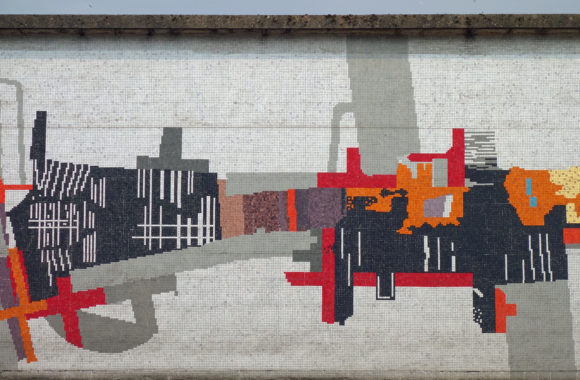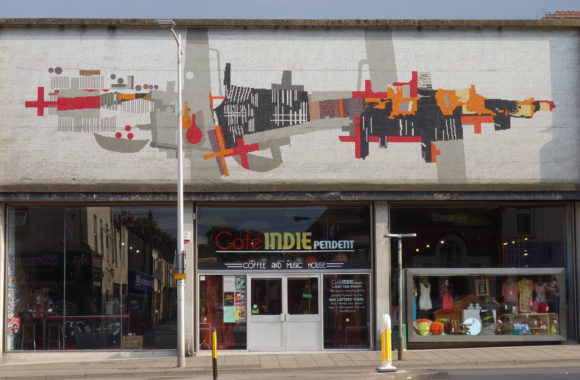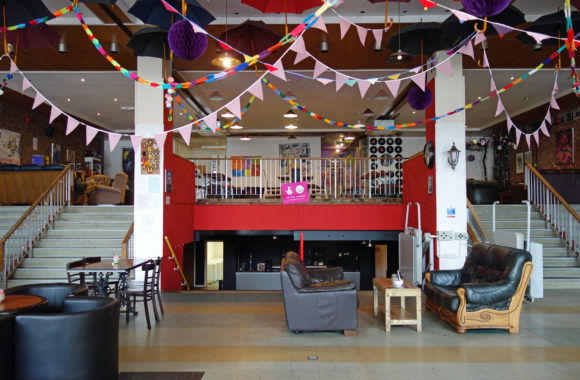This website uses cookies
This website uses cookies to enable it to function properly and to analyse how the website is used. Please click 'Close' to accept and continue using the website.



February 2020 - Co-operative Pharmacy, Scunthorpe, Lincolnshire
Derek W Brown, 1963.
by Lynn Pearson
Why was Scunthorpe’s unusual and stylish co-op pharmacy totally ignored by all but the local press when it opened in 1963? Co-op buildings featured regularly in architectural journals between the wars, when they were seen to be near the leading edge of British design, but later – though still innovative – stores of the 1960s escaped attention completely. Co-operators themselves were not concerned with stylistic issues, simply wanting to erect buildings that were assets to the locality, functional and, crucially, value for money. The neglect of Scunthorpe’s pharmacy may also be related to its location in a (relatively) small Lincolnshire industrial town.
The designer of Scunthorpe’s co-op pharmacy was the local architect Derek W Brown. Earlier iterations of his practice, Brown & Buttrick, had worked for Scunthorpe Mutual Co-operative and Industrial Society (founded 1874) in the early twentieth century. The society’s membership increased alongside the town’s rapidly expanding iron and steelworks, reaching 24,000 in 1924 and 60,000 at the start of the 1970s. The society built a series of branch stores in surrounding villages, sometimes using the architectural services of the Co-operative Wholesale Society, the movement’s main federal body. But Scunthorpe co-op demonstrated its robust independence of the centre by commissioning young local architect Walter H Buttrick (1882–1961) to design a branch in 1907; this was the start of an association between the society and the practice that was to continue for over half a century. Architects working with co-ops had to pilot their plans through lengthy and detailed discussions with building committees. Once an architect or practice established a positive working relationship, interesting designs might result. A financially successful society like Scunthorpe’s could afford to back the newfangled ideas of their architects.

The practice eventually developed into Buttrick & Buttrick, and by the late 1950s Brown & Buttrick, when Derek W Brown became a partner. Their Modernist-influenced works included an unusually angular house at Thorpe on the Hill near Lincoln (winner of a Civic Trust Award in 1962), and the Church of the Holy Spirit (1960–2) in the Scunthorpe suburb of Riddings, famous for its 120ft (37m) high openwork blue steel spire.
Brown took on the practice’s co-op commissions, firstly designing a striking petrol station (1957) with an up-to-the-minute broad, flat canopy, near the town’s railway station. Next came an equally fashionable blank-walled supermarket (1958) – the town’s first – in the suburb of Ashby, its interior tricked out with a steel staircase, a sophisticated American lighting system and a red plastic mural. It cost £80,000 in all, but Scunthorpe co-op was willing to support Brown’s dashing plans, which featured several more murals. The facade of the society’s remodelled bookshop (1959) in the town centre was dominated by a large photo mural (particularly effective at night), while the society’s hair salon (1961) boasted a large external mosaic panel and an internal, full height photo mural.
The culmination of Brown’s efforts was hailed by the Scunthorpe Evening Telegraph as ‘a new landmark for Scunthorpe’ when the High Street pharmacy opened on 1 November 1963. It was the largest co-operative pharmacy in Britain, stocking high-end cosmetic brands and boasting slimming and hearing aid departments, as well as a camera centre equipped with a film library. This all occupied a split-level interior comprising lower ground and ground floors, with a mezzanine gallery above. The basic layout was retained after a serious fire in 1967, which fortunately appears to have left the mural undamaged, along with a large ‘panorama showcase’ in the right-hand window. The plate glass frontage and showcase are remarkably well preserved.

The whole upper facade is covered by the pharmacy-themed abstract mosaic, measuring 52ft (16m) by 14ft (4m). It was designed by well-known shopfitters Harris & Sheldon in conjunction with Brown, and executed by mosaic specialists O Toffolo & Son of Hull. Harris & Sheldon worked on numerous co-ops, and like most sizeable shopfitting firms, employed their own artists and architects. The Scunthorpe mural is one of only four surviving large-scale English co-op murals from the 1950s and 1960s, along with those at Stevenage (1957–8), Hull (1961–3) and Ipswich (1963–4). All share a co-operative movement theme, while also relating to local industries and communities. These tile and mosaic murals represent a significant but potentially endangered public display of co-operation’s ethos and heritage (for Stevenage, Ipswich and Hull see the C20 Society Murals Campaign webpage). Given the uncertain future of Hull’s Three Ships mural, the continued survival of Scunthorpe’s pharmacy mural becomes even more significant.
Like many co-ops, Scunthorpe’s society eventually suffered a decline in its fortunes, merging with Co-operative Retail Services, a federal body, in 1973; the store continued to be run as a pharmacy for some years. More recently it has become an independent co-operative café and events venue. Although the stairs have been renewed, the three-level interior still retains an atmosphere of the original store. The mural itself is best seen at the height of summer, when the north-facing mosaic catches early morning and late evening sunlight.
Lynn Pearson (@lynnpearson67) is an independent architectural historian and photographer. Her book England’s Co-operative Movement: An Architectural History will be published by the Historic England imprint of Liverpool University Press in autumn 2020. Her book on Victorian and Edwardian industrial architecture was published in 2016. The Building of the Month feature is edited by Dr. Joshua Mardell.
Look for past Buildings of the Month by entering the name of an individual building or architect or browsing the drop down list.

Become a C20 member today and help save our modern design heritage.